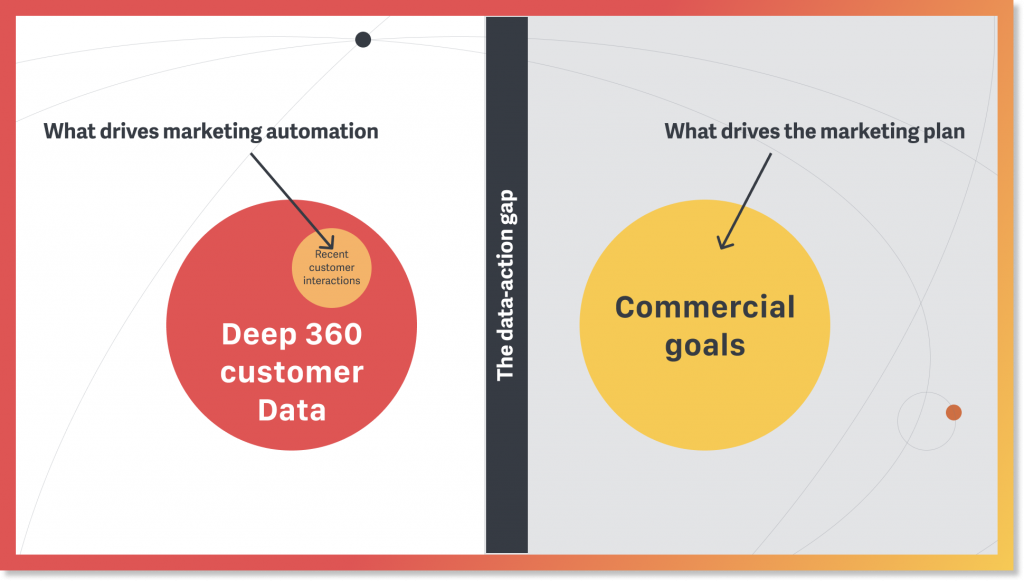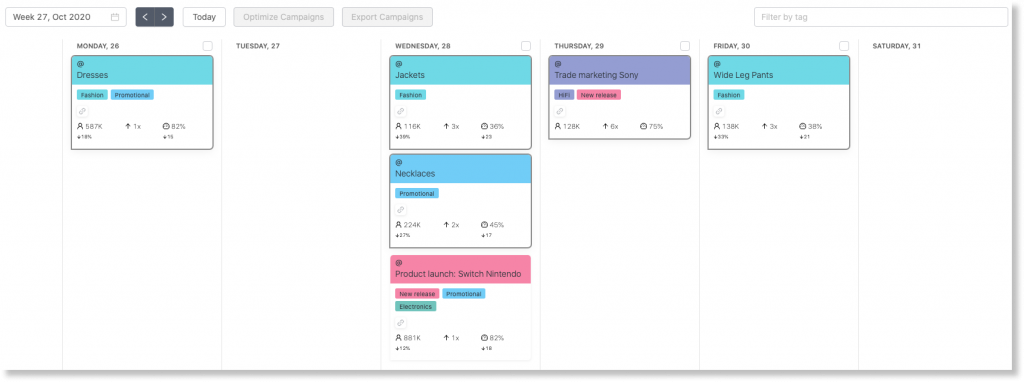Your company has been considering using a Customer Data Platform – or CDP – for some time now.
You’ve chatted with a few sales reps.
Are you planning the investment in next year’s budget?
Or have you already completed the lengthy IT & data setup?
Is all your data finally in good standing?
Have your teams been trained to use the tool?
Have you started running campaigns based on the data in your CDP?
Do you like the results you’re seeing?
Are you confident the whole thing was really worth the time, money, and effort?
Now what?
“B2C CDPs: all the hype, none of the follow-through” — Forrester
Though indispensable to gather and structure the large amounts of customer data companies generate these days, CDPs are a disappointing category according to industry experts.
Earlier this year, Joe Stanhope, VP Principal Analyst, and Stefanie Liu, Analyst at Forrester, wrote in the report B2C CDPs Need To Survive Before They Can Thrive:
“CDPs need to achieve functional competency and extend their automation and intelligence capabilities to drive better business outcomes for marketers.”
The lack of actionable analytics delivering serious ROI is a broader industry problem. In their recently published Marketing Data and Analytics Survey 2020, Gartner research consultancy note that:
“Over 50% of senior marketing leaders are unimpressed with the results they receive from marketing analytics investments.”
For CDPs, the gap from expectations to reality is yet to be bridged. The battle for hard-proven ROI is yet to be won.
What CDPs solve
For businesses that handle large amounts of customer data, especially when a lot of shopping happens online, CDPs are a meaningful category.
A single source of truth
On the plus side, CDPs solve three main problems of today’s marketing:
- The identity resolution challenge
- Data accessibility and governance
- Interconnectedness
The ability to have a single source of truth for marketing data is a must-have for all businesses.
Marketers need to trust their data platforms, free from isolated data silos, to be able to make educated decisions on marketing investments.
If an experience cloud manages to become this single source of truth for marketing data, it will implicate a lifelong stickiness of that solution to a business.
Customer marketing = 10% driven by customer behavior + 90% driven by commercial goals
But adding a CDP does not magically change the way customer marketing is done. The main CRM tactics remain unchanged:
- Mass/blast campaigns sent to the entire customer database to maximize reach — at the risk of annoying customers. This typically represents 90% of outbound messages.
- Campaigns targeted based on manually defined queries (e.g. promoting the new summer dress to every client who bought women products in the past 3 years) or high-level/generic segmentation (churn prediction, the likelihood that a customer will buy any product…)
- Customer journeys reacting to classic consumption scenarios, such as customer onboarding (welcome flow, birthday email), remarketing (“you have one item in your cart”), and cross-sell (“you might also like”).
CDPs can enrich segmented campaigns and customer journeys with more data points but I suspect the revenue uplift will be marginal. Here is why:
Marketing Cloud solutions have promoted journey automation as the foundation of self-driven marketing and this is key to understanding the CDP activation issue. Marketing’s top goal is to drive new interest and not just react to pre-existing interest.
What I have learned over my years at Tinyclues that if you only focus on the 10% of customer marketing that is primarily driven by customer behavior, you quickly hit a glass ceiling.
This is the blindspot of marketing automation and CDPs:
To really move the needle, marketers need to tackle the 90% of their messages that are driven by commercial goals.
Right now spam-like tactics remain the dominant paradigm for these campaigns. This is where customer-centricity collides with reality.
What CDPs don’t solve
In a perfect world, marketing would be 100% customer-centric
Marketers are faced with what we, at Tinyclues, call the data-action gap.
In a nutshell, the data-action gap is the disconnect between expectations of customer-centricity and the reality of how marketing plans are built.
In a perfect world, customer data should inform all marketing actions, not just the 10% of messages that are indeed influenced by recent customer behavior. But business inputs (product launches, inventory issues, your competitor’s latest move or how far you are from your revenue goals) are the primary drivers of your weekly/monthly marketing plan.
These two types of data live in two different worlds, on different systems. CDPs offer no promise to unify them. In practice, marketers still build their marketing plan using Excel sheets!
In the real world, commercial goals drive the marketing plan
Organizations are thinking top-down and they’re building their marketing plans based on their commercial agenda, not their customers’ preferences.
Decisions are informed by what managers want, not by what customers need.
When your boss walks into the room and asks for your plan to boost next month’s revenue, the answer CANNOT be customer-centric.
Let’s face it, marketers are here to support the business. Week after week, they are under tremendous pressure to:
- Generate online and offline traffic from as many customers as possible, regardless of their engagement level.
- Push specific products and offers based on commercial priorities.
- Deliver growth and revenue according to ambitious, hard-to-achieve targets.
Basically, organizations put marketers under so much pressure that they often have to sacrifice customer-centricity and lifetime-value in the name of short-term revenue metrics.
Without smart decisioning anchored in the reality of commercial goals, CDPs are a bridge to nowhere.
What marketers need is a system that:
1/ factors both customer data AND commercial goals,
2/ offers smart decisioning capabilities adapted to the dynamic nature of business constraints,
3/ enables usage patterns compatible with the reality of campaign production workflows.
This is what Tinyclues does. It is an intuitive and collaborative tool that allows marketers to intelligently plan the 90% of their customer marketing messages that solve commercial problems.
Tinyclues is powered by anonymized first-party data (CRM, online/offline purchase, marketing logs…) and connects to all major Marketing Clouds & CDPs.
In a nutshell, Tinyclues identifies opportunities that marketers would have left on the table, builds the best customer audiences without any reach limitation, and adds value-driven decisioning capabilities.
Because it is centered on marketers’ real-life problems, its UX is centered on an interactive campaign calendar.
Customer-centricity meets commercial goals: a call for pragmatic marketing
It’s not just about customer data. It’s about marketer empowerment.
Don’t get me wrong. Customer-centricity is mandatory. But it cannot come at the expense of solving the real problems marketers face every day.
CDPs are part of the solution, but they lack the final mile, the business-centric decision layer that will articulate customer data with this week’s commercial goals, in a UX that is simple, intuitive, and built for marketers.
The final mile: from customers to business
Tinyclues is specifically designed to solve the key problems customer marketing teams face every day.
Problem #1: your organization wants you to push the latest offer or a product that is hard to sell.
To boost high-contributions sales, Air France wanted to diversify its commercial campaigns to not only promote destinations but also specific types of cabin and departure windows (last minute, early booking…). Using Tinyclues, Air France now leverages its data to its full extent to go beyond booking history and reaches new potential bookers on offers that Air France’s management specifically wants to promote.
Problem #2: you’re supposed to promote 7 different items next week but you can only send 2 messages per customer.
A top 10 global luxury brand based in the US faced a dilemma every week. Let’s say they had 10 different campaign goals to promote (Home&Accessories, Diamond Jewelry, Gold…) in the days prior to Black Friday. Using Tinyclues, they now identify customers specifically interested in the promoted content(even if they have never shared an explicit interest for this topic), orchestrate this group of campaigns to make sure that nobody received more than 5 (a set volume decided by the marketing) campaigns out of the 10 and nobody received more than 1 in a given day. An Excel spreadsheet or a workflow first-come-first-serve can not help, Tinyclues can.
Problem #3: your company is late on its revenue goals and your boss asks you to do something about it.
TUI, one of the largest tour operators globally, uses Tinyclues’ Insights to refine their campaign planning and compliment larger brand messages. The untapped revenue potential is identified by Tinyclues and a new inspirational campaign baptized “What do you think of” is sent to the best 5% of the customer database that will generate 80% of the overall revenue for this content. Creating a new revenue stream without damaging customer engagement.
Because this pragmatic, problem-solving approach is rooted in their real-life challenges and immediately delivers quantified results, it makes our customers happy.
Adding Tinyclues on top of your CDP puts you on the fast track. CDPs are great tools to unify customer data across your organization. But if you want to turn this data into action & solve the dynamic marketing problems that your organization wants you to deliver on every week, Tinyclues is the best option on the table.
The gap is bridged.
Safe travels now 🚙






